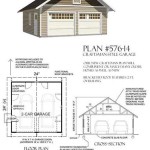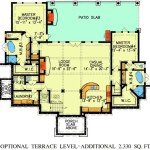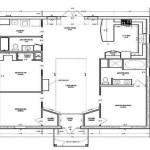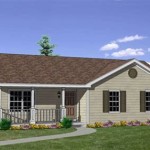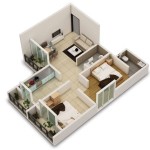Floor Plan Ideas For Small House
Designing a small house requires careful consideration and strategic planning to maximize space and functionality. The floor plan serves as the foundation for creating a comfortable and efficient living environment. Effective small house floor plans prioritize open layouts, flexible spaces, and clever storage solutions. This article will explore various floor plan ideas suitable for small houses, focusing on principles of space optimization and functional design.
Open Concept Living Spaces
One of the most popular and effective strategies for small house design is adopting an open concept layout. This approach typically combines the living room, dining area, and kitchen into a single, unified space. By eliminating dividing walls, the feeling of spaciousness is significantly enhanced, allowing natural light to permeate throughout the entire area. This open flow encourages social interaction and makes the home feel larger and more inviting.
When implementing an open concept layout, it is essential to define distinct zones within the single space. This can be achieved through various methods, such as using area rugs to delineate the living room seating arrangement, placing a kitchen island to separate the cooking area from the dining space, or using changes in flooring material to subtly indicate different zones. Furniture placement also plays a critical role; strategically positioned sofas, bookshelves, or even a change in ceiling height can contribute to defining areas without the use of walls.
Consider the flow of traffic within the open concept space. Pathways should be clear and unobstructed, allowing for easy movement between different zones. Avoid overcrowding the space with too much furniture, which can negate the benefits of the open layout. Instead, opt for multi-functional furniture pieces that can serve multiple purposes, such as a coffee table with built-in storage or a sofa that converts into a bed. A well-designed open concept living space can transform a small house into a comfortable and functional home.
Natural light plays a vital role in enhancing the feeling of spaciousness in an open concept layout. Maximize the amount of natural light entering the space by incorporating large windows, skylights, or glass doors. The strategic placement of mirrors can also help to reflect light and create the illusion of a larger space. Light-colored walls and ceilings further contribute to the brightness and airiness of the room.
Multi-Functional Rooms and Furniture
In small houses, every square foot counts. Designing spaces and selecting furniture that can serve multiple purposes is crucial for maximizing efficiency. A guest room that doubles as a home office, a dining table that can be folded away when not in use, or a storage bed that provides ample space for belongings are all examples of how to make the most of limited space. This approach requires careful planning and consideration of how each space will be used at different times of the day.
The use of convertible furniture is especially beneficial in small houses. Sofa beds, folding chairs, and nesting tables are all excellent examples of furniture that can be easily adapted to meet changing needs. These pieces allow for flexibility in the use of the space, making it possible to accommodate guests or create a temporary workspace without sacrificing valuable floor space. When selecting multi-functional furniture, consider its durability, ease of use, and aesthetic appeal.
Beyond furniture, the rooms themselves can be designed to serve multiple purposes. For example, a bedroom could incorporate a built-in desk area for working from home, or a living room could include a Murphy bed to provide extra sleeping space for guests. These integrated solutions require careful planning during the design phase but can significantly enhance the functionality of a small house. Consider built-in shelving and storage solutions to maximize vertical space and keep clutter at bay.
When planning for multi-functional rooms, consider the acoustics and privacy needs of each activity. For example, a home office located in a bedroom should be designed to minimize distractions and provide a quiet workspace. This can be achieved through the use of soundproofing materials, strategic placement of furniture, or the addition of room dividers. Similarly, a guest room should provide adequate privacy and comfort for visitors. The successful integration of multiple functions into a single space requires careful attention to detail and a thorough understanding of the needs of the occupants.
Vertical Space Utilization and Storage Solutions
One of the most overlooked aspects of small house design is the utilization of vertical space. By maximizing the height of the walls, it is possible to create ample storage and display areas without sacrificing valuable floor space. This can be achieved through the use of tall bookshelves, cabinets that reach the ceiling, and vertical storage systems. Furthermore, loft spaces can be incorporated to create additional living or storage areas.
Built-in storage solutions are particularly effective in small houses. These can be customized to fit specific needs and can be integrated seamlessly into the design of the home. Examples include built-in wardrobes in bedrooms, kitchen cabinets that extend to the ceiling, and shelving units that are integrated into the walls. Built-in storage not only maximizes space but also creates a clean and organized look.
Consider the use of floating shelves to create visual interest and provide additional storage without taking up floor space. These shelves can be used to display books, artwork, or decorative items, adding personality to the room. When designing vertical storage solutions, consider the accessibility of the items being stored. Regularly used items should be placed within easy reach, while less frequently used items can be stored higher up. Lighting is also an important consideration; ensure that vertical storage areas are well-lit to make it easier to find and access items.
Loft spaces can be a valuable addition to small houses, providing extra living or storage areas. These spaces can be accessed via a ladder or staircase and can be used as a bedroom, home office, or simply as a storage area. When designing a loft space, consider the height of the ceiling and ensure that it is comfortable to stand and move around in. Adequate ventilation and lighting are also essential for creating a functional and comfortable loft space. Utilizing vertical space can significantly enhance the functionality and livability of a small house.
Under stair storage is another often overlooked area that can be transformed into a useful space. Custom cabinets or drawers can be built into the space beneath the stairs to store shoes, coats, or other household items. This makes use of an otherwise wasted area and helps to keep the rest of the house tidy and organized. A well-designed under stair storage solution can significantly improve the functionality of a small house.
In the kitchen, consider utilizing vertical space with pot racks hung from the ceiling. This frees up cabinet space and makes pots and pans easily accessible. Spice racks can also be mounted on the walls to keep spices organized and within reach. In the bathroom, install shelves above the toilet to store toiletries and towels. These small changes can make a big difference in the overall organization and functionality of a small house.
Maximizing storage also involves decluttering regularly. Regularly assess belongings and remove items that are no longer needed or used. This helps to prevent clutter from accumulating and makes it easier to keep the house organized. Consider donating or selling unwanted items to further reduce clutter. A decluttered home feels more spacious and inviting, even in a small house.
When planning your small house floor plan, remember to consider the flow of natural light. Ensure that windows are not blocked by furniture or storage units. Consider using sheer curtains or blinds to allow light to filter through while maintaining privacy. Natural light can make a small house feel brighter and more spacious.
Another important consideration is the placement of electrical outlets and light fixtures. Ensure that there are enough outlets to accommodate your electrical needs, and that they are conveniently located. Consider installing dimmer switches to control the amount of light in each room. Proper lighting can enhance the functionality and ambiance of a small house.
In conclusion, designing a floor plan for a small house requires careful planning and attention to detail. By prioritizing open concept living spaces, utilizing multi-functional rooms and furniture, and maximizing vertical space and storage solutions, it is possible to create a comfortable and functional home, even in a limited space. Remember to consider the flow of traffic, the amount of natural light, and the placement of electrical outlets and light fixtures. With careful planning and creativity, a small house can be transformed into a stylish and efficient living space.

Small House Design 2024001 Pinoy Eplans Floor Plans

Small House Design 2024005 Pinoy Eplans Modern Plans Layout

Small House Plans With S Houseplans Blog Com

10 Small House Plans With Open Floor Blog Homeplans Com

18 Small House Designs With Floor Plans And Decors

10 Small House Plans With Open Floor Blog Homeplans Com

Small House Design Series Shd 2024008 Pinoy Eplans

Small House Plan Examples

Small House Plans And Design Ideas For A Comfortable Living

Longshoremans Daughter Small House Floor Plans Tiny

